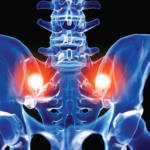“If you just focus on bone marrow edema and the range (of lesions) is between two and four, then the specificity is low and, you do not see erosion, then you have to be cautious,” says Dr. Weber. “This could be mechanical strain.”
First published in a 2009 article in the Annals of Rheumatic Diseases, the ASAS classification criteria for axial spondyloarthritis define a positive MRI to diagnose sacroiliitis as one bone marrow edema lesion in two consecutive MRI slices or two or more bone marrow edema lesions on a single slice.2 The 97% specificity of the imaging arm of the ASAS axial spondyloarthritis classification criteria mistakenly led some rheumatologists to believe the sacroiliac joint changes on MRI, as defined by the criteria, could be used for diagnostic purposes in clinical practice, notes rheumatologist Atul Deodhar, MD, professor of medicine at Oregon Health & Science University, Portland, Ore.
The well-designed study by Dr. Weber and colleagues adds to the growing literature that shows low-grade bone marrow edema, fulfilling the ASAS definition, is seen in 25% of healthy individuals, plus in patients with nonspecific mechanical back pain, says Dr. Deodhar.
“We can draw two conclusions from this study,” says Dr. Deodhar. “First, classification criteria should not be used for making a diagnosis, and second, the definition of positive MRI of the SI joints for discrimination of early axSpA needs to be modified by a data-driven approach.”
Dr. Weber advises rheumatologists to be cautious with the definition of active sacroiliitis when considering MRI results and to consider that isolated low-grade bone marrow edema may be insufficient to diagnose early axial spondyloarthritis. He also notes the disease is much more likely present if an MRI displays concomitant erosion and other structural lesions.
Catherine Kolonko is a medical writer based in Oregon.
References
- Weber U, Jurik AG, Zejden A, et al. Frequency and anatomic distribution of magnetic resonance imaging features in the sacroiliac joints of young athletes. Exploring ‘background noise toward a data‐driven definition of sacroiliitis in early spondyloarthritis. Arthritis Rheumatol. 2018 May;70(5):736–745.
- Rudwaleit M, van der Heijde D, Landewé R, et al. The development of Assessment of SpondyloArthritis International Society classification criteria for axial spondyloarthritis (part II): Validation and final selection. Ann Rheum Dis. 2009 Jun;68(6):777–783.

